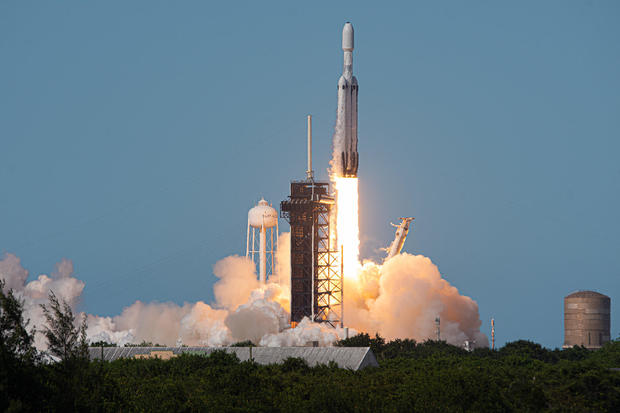
SpaceX Falcon Heavy rocket launches powerful hurricane-hunting weather satellite
A powerful SpaceX Falcon Heavy rocket boosted a hurricane-hunting GOES weather satellite into orbit Tuesday, the final member of a four-satellite fleet at the heart of an $11 billion upgrade to the nation’s forecasting infrastructure.
“NOAA’s geostationary satellites are an indispensable tool for protecting the United States and the one billion people who live and work in the Americas,” said Pam Sullivan, GOES program director. “They provide a constant real-time view of weather and dangerous environmental phenomena across the western hemisphere.”
William Harwood/CBS News
Appropriately enough, the primary obstacle to launch of the latest Geostationary Operational Environmental Satellite — GOES-U — was the same sort of weather it was built to observe. Forecasters predicted a 70 percent chance of late afternoon storms that threatened prevent takeoff.
space weather as well, imaging the sun’s ultraviolet and X-ray emissions, measuring changes in the solar wind and magnetic fields on the lookout for solar flares and other high-energy events.
In addition, a new instrument called the Compact Coronagraph-1 will study the sun’s outer atmosphere, or corona, to detect coronal mass ejections, huge explosions that send torrents of electrically charged particles into the solar system. A coronal mass ejection was responsible for the spectacular auroral displays visible across North America on May 10 and 11.
“For the first time, we will have continuous observations of the sun’s fainter outer atmosphere, creating the equivalent of a total solar eclipse every 30 minutes,” said Elsayed Talaat, NOAA’s director of space weather observations.
“In doing so, this powerful solar telescope allows to observe the corona, which is the region where extreme space weather events originate. The chronograph, working in tandem with a magnetometers, solar ultraviolet imagers and extreme ultraviolet and X ray irradiance sensors will strengthen NOAA’s ability to predict space weather.”
GOES-19 is the final member in a set of four advanced satellites, each one costing roughly $500 million. GOES-R, now GOES-16, was the first satellite in the series, launched in November 2016. NOAA is developing even more powerful satellites that eventually will replace GOES-16, 17, 18 and 19.
More
More
Source: cbsnews.com